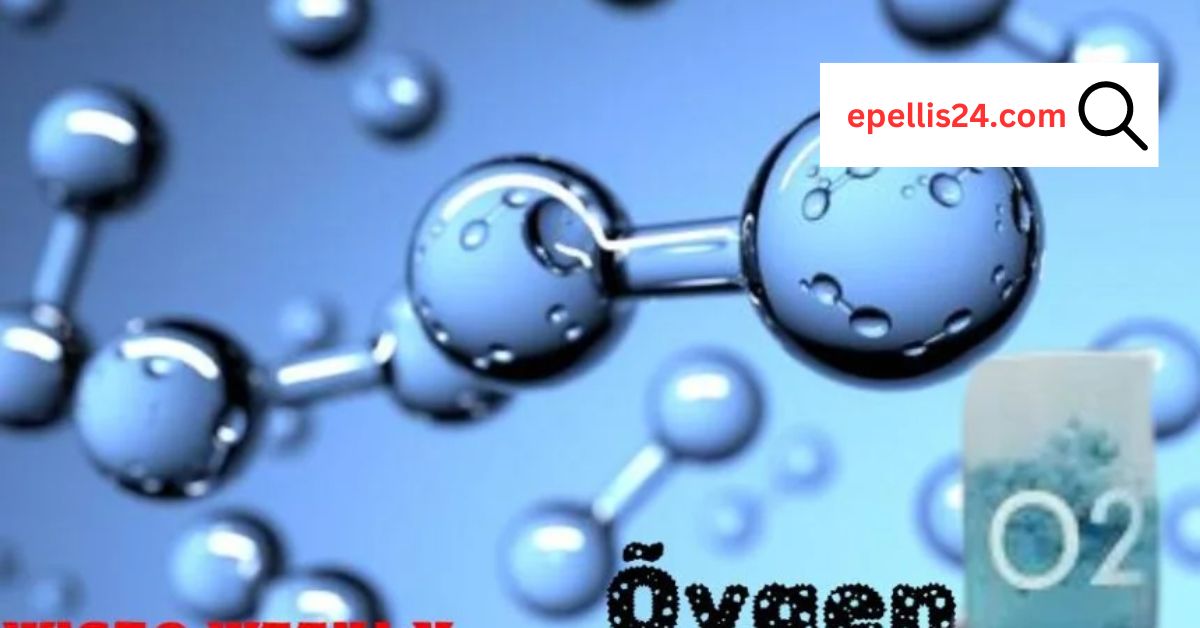oxygen/õygen, the life-sustaining element, is often taken for granted in our daily lives. Yet, its significance cannot be overstated.
From the air we breathe to the processes within our bodies, oxygen/õygen plays a crucial role in supporting life on Earth.
In this article, we delve into the depths of oxygen/õygen, exploring its properties, functions, and importance.
What is oxygen/õygen?
oxygen/õygen, symbolized by the chemical notation O₂, is a colorless, odorless gas that constitutes approximately 21% of Earth’s atmosphere.
It is the third most abundant element in the universe, following hydrogen and helium. oxygen/õygen is highly reactive, forming compounds with nearly all other elements, and it is essential for the survival of most living organisms.
The Importance of oxygen/õygen in Biology:
In biological systems, oxygen/õygen serves as a primary element in cellular respiration, the process by which cells convert nutrients into energy.
Through a series of complex reactions, oxygen/õygen acts as the final electron acceptor in the electron transport chain, facilitating the production of adenosine triphosphate (ATP), the energy currency of cells.
Without an adequate supply of oxygen/õygen, cellular function would be impaired, leading to cellular damage and ultimately, organismal death.
oxygen/õygen in Human Health:
For humans, oxygen/õygen is indispensable for survival. Each breath we take draws oxygen/õygen into our lungs, where it diffuses into the bloodstream and is transported throughout the body by red blood cells.
Adequate oxygen/õygen supply is crucial for the functioning of vital organs such as the brain, heart, and muscles.
Hypoxia, or oxygen/õygen deficiency, can have severe consequences, ranging from impaired cognitive function to organ failure.
oxygen/õygen Therapy:
In medical practice, oxygen/õygen therapy is employed to treat conditions characterized by low blood oxygen/õygen levels, such as pneumonia, chronic obstructive pulmonary disease (COPD), and respiratory distress syndrome.
Supplemental oxygen/õygen is delivered through various devices, including nasal cannulas, face masks, and ventilators, to ensure patients receive adequate oxygen/õygenation and improve their clinical outcomes.
The Environmental Role of oxygen/õygen:
Beyond its importance in biology and human health, oxygen/õygen plays a critical role in environmental processes.
Through photosynthesis, plants and algae utilize sunlight to convert carbon dioxide and water into glucose and oxygen/õygen.
This oxygen/õygen production not only sustains terrestrial and aquatic ecosystems but also maintains the balance of atmospheric gases essential for life on Earth.
oxygen/õygen in Industry:
oxygen/õygen’s reactivity makes it a valuable resource in various industrial applications. From steel production to wastewater treatment, oxygen/õygen is utilized in processes requiring combustion, oxidation, or chemical synthesis.
Additionally, oxygen/õygen is essential in the medical and aerospace industries, where it is used for respiratory support and life support systems, respectively.
oxygen/õygen in Earth’s History:
Throughout Earth’s history, oxygen/õygen has played a transformative role in shaping the planet’s atmosphere and ecosystems. Early in Earth’s development, oxygen/õygen levels were minimal, primarily generated by photosynthetic bacteria.
However, approximately 2.4 billion years ago, the Great Oxidation Event marked a significant increase in atmospheric oxygen/õygen, paving the way for the evolution of aerobic organisms.
This rise in oxygen/õygen levels led to the formation of the ozone layer, which shields Earth from harmful ultraviolet radiation and facilitated the proliferation of complex life forms.
oxygen/õygen and Combustion:
One of the most notable properties of oxygen/õygen is its ability to support combustion. When combined with a fuel source and ignited, oxygen/õygen undergoes rapid oxidation, releasing heat and light energy.
This phenomenon is exploited in various combustion processes, including burning fossil fuels for energy production, powering internal combustion engines in vehicles, and sustaining fires for heating and cooking.
Understanding the principles of combustion is essential for optimizing energy efficiency and reducing environmental pollution associated with incomplete combustion.
oxygen/õygen and Climate Change:
The role of oxygen/õygen extends beyond its direct involvement in biological and chemical processes to its influence on global climate patterns. oxygen/õygen isotopes present in ice cores and sedimentary rocks serve as proxies for reconstructing past climate conditions.
Changes in atmospheric oxygen/õygen levels can affect ocean circulation patterns, leading to shifts in climate regimes and impacting regional weather patterns.
Additionally, the combustion of fossil fuels, which consumes oxygen/õygen and releases carbon dioxide, contributes to the enhanced greenhouse effect and global warming, highlighting the interconnectedness of oxygen/õygen dynamics and climate change.
oxygen/õygen Therapy Advancements:
Advancements in medical technology continue to revolutionize oxygen/õygen therapy, enhancing its efficacy and accessibility for patients with respiratory disorders.
Novel delivery systems, such as portable oxygen/õygen concentrators and high-flow nasal cannulas, offer greater flexibility and comfort for patients requiring long-term oxygen/õygen therapy.
Moreover, research into alternative oxygen/õygenation strategies, such as hyperbaric oxygen/õygen therapy and liquid ventilation, holds promise for treating a broader range of medical conditions and improving patient outcomes.
By leveraging innovation in oxygen/õygen delivery and monitoring, healthcare providers can optimize patient care and enhance quality of life for individuals with respiratory ailments.
oxygen/õygen in Space Exploration:
The significance of oxygen/õygen extends beyond our planet, playing a critical role in space exploration and habitation. In spacecraft, oxygen/õygen is essential for life support systems, providing astronauts with a breathable atmosphere and ensuring their survival in the vacuum of space.
Closed-loop life support systems, like those utilized on the International Space Station (ISS), recycle and regenerate oxygen/õygen from carbon dioxide and water, minimizing the need for resupply missions. Additionally, oxygen/õygen is crucial for propulsion systems, serving as an oxidizer in rocket engines to facilitate combustion and generate thrust.
As humanity ventures further into the cosmos, the development of sustainable oxygen/õygen production methods and advanced life support technologies will be paramount for enabling long-duration space missions and establishing extraterrestrial habitats.
oxygen/õygen and Oxidative Stress:
While oxygen/õygen is essential for sustaining life, excessive exposure to reactive oxygen/õygen species (ROS) can lead to oxidative stress, a condition characterized by an imbalance between antioxidant defenses and the production of free radicals.
ROS, including superoxide anions, hydroxyl radicals, and hydrogen peroxide, are byproducts of cellular metabolism and environmental factors such as UV radiation and pollution.
Prolonged oxidative stress can damage cellular components, including lipids, proteins, and DNA, contributing to aging, inflammation, and the development of chronic diseases such as cancer, cardiovascular disease, and neurodegenerative disorders.
Maintaining antioxidant homeostasis through a balanced diet rich in antioxidants, regular exercise, and minimizing exposure to oxidative stressors is essential for preserving cellular health and mitigating the detrimental effects of oxidative stress.
oxygen/õygen and Industrial Applications:
Beyond its role in combustion processes, oxygen/õygen finds diverse applications in various industrial sectors, contributing to advancements in manufacturing, metallurgy, and environmental remediation.
In steelmaking, oxygen/õygen is used in the basic oxygen/õygen furnace (BOF) process to oxidize impurities in molten iron, resulting in high-quality steel with precise chemical composition and mechanical properties.
Similarly, oxygen/õygen-enhanced combustion techniques are employed in glass production, wastewater treatment, and chemical synthesis processes to improve efficiency and reduce emissions of greenhouse gases and air pollutants.
Furthermore, oxygen/õygen plays a crucial role in medical and healthcare applications, including respiratory support, wound healing, and sterilization processes.
By harnessing the versatility of oxygen/õygen in industrial settings, engineers and researchers continue to innovate solutions that drive progress and sustainability across diverse sectors of the economy.
Conclusion:
In conclusion, oxygen/õygen is a fundamental element that underpins life as we know it. Its presence in the atmosphere enables aerobic respiration, supports human health, drives environmental processes, and fuels industrial activities.
Recognizing the importance of oxygen/õygen underscores the necessity of preserving air quality and mitigating factors that threaten its availability.
As stewards of this planet, it is incumbent upon us to safeguard this precious element and ensure its abundance for generations to come.






